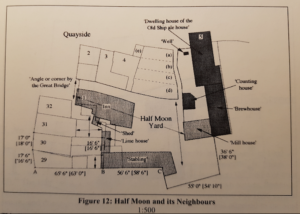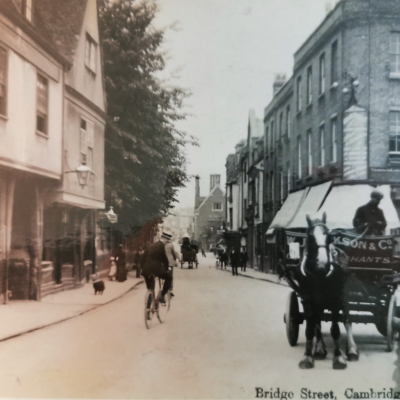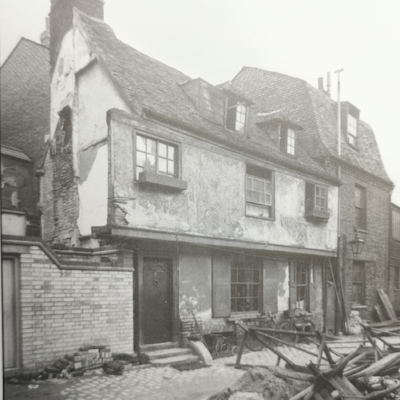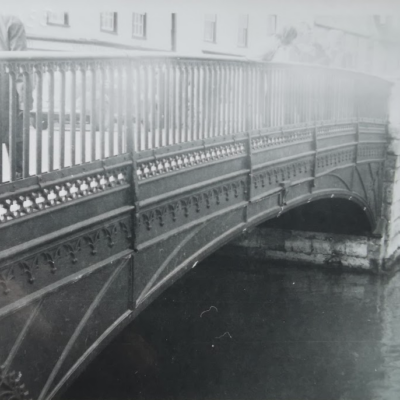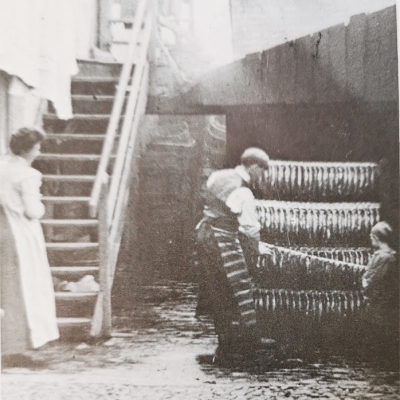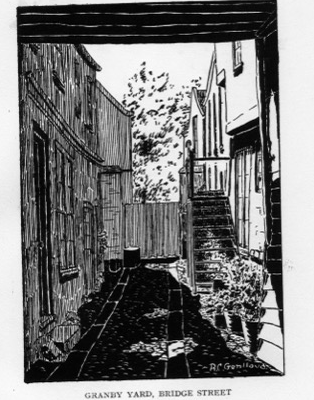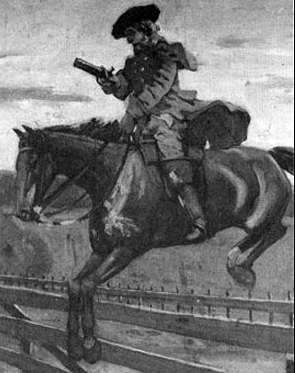Search by topic
- archaeology
- Building of Local Interest
- chapel
- charity
- church
- crime
- dressmaker
- fire
- Great Eastern Railway
- Listed building
- Mapping Relief
- medieval
- oral history
- poverty
- Public House
- Religious House
- Roman
- scholar
- school
- Then and Now
- tudor
- women
- work
- world war one
- world war two
Search by text
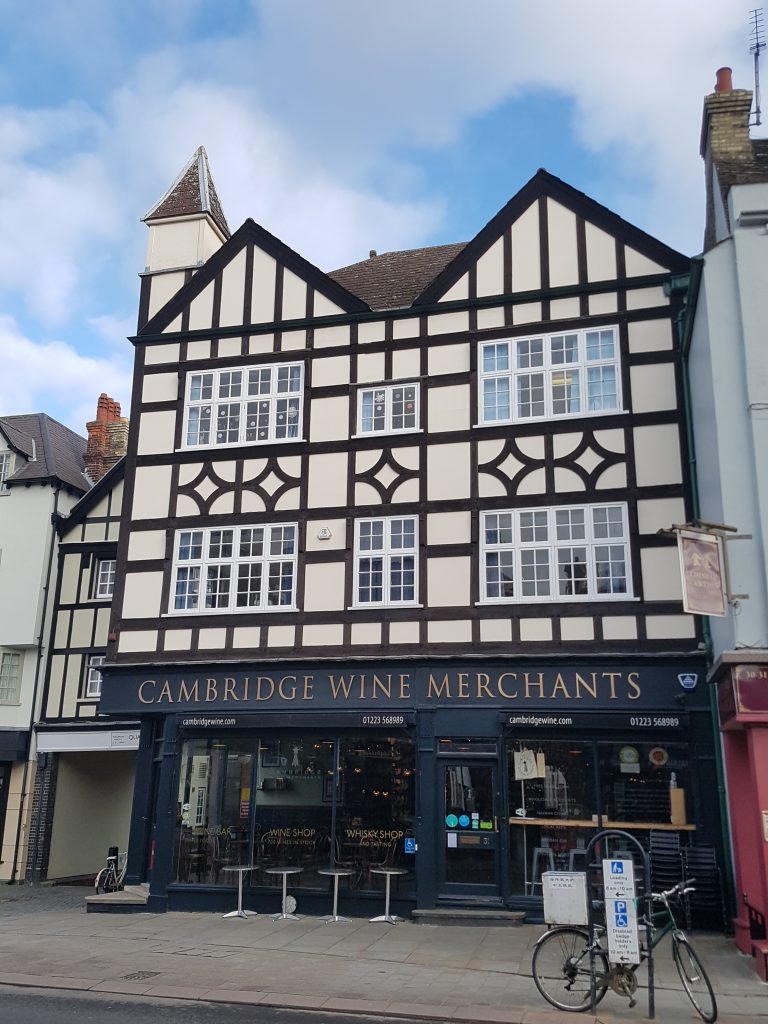
31 Bridge Street (31 – 32) / Anchor Inn
History of 31 Bridge Street
For detailed information on this site see T E Faber, An Intimate History of the St Clement’s Parish, 2006.
Magdalene College acquired four old deeds in 1902 relating to no. 31 Bridge Street. The 1886 OS map used above shows two properties nos. 31 and 32. In the 20th cent. no. 32 was transferred to what had been 2 Quayside. So the modern 31 Bridge Street was original two properties, sometime nos 31 and 32.
It seems that after the Black Death the location became derelict. The following transaction evidence the new development in the area.
William and Elizabeth Lolleworth held no. 31 in the second half of the 15th cent.
1494 conveyance from Thomas Smyth clerk, executor of Elizabeth Lolleworth to William Bele, burgess of Cambridge
1499 from William Bele to John Heddynglay and his wife Joan
1501 from John and Joan Hedynglay to William Stevynson and his wife Isabell
1507 from Edmund Dumay to William Stevynson. This transaction brought the garden behind no.31 into common ownership with the house.
1509 Christopher Stanks then William Richardson
1559 death of William Richardson; property left to wife.
1577 house passed from Richardson’s widow to Miles Prance. Prance then used part of the garden to extend the Half Moon.
1580 death of Miles Prance. he was still paying 2d rent for a chimney associated with no. 32. Property already transferred to daughter Agnes as part of her marriage settlement. Agnes and her husband John Wilkinson had ppossibly been living in no. 32 since their marriage at St Clement’s in 1572. No. 31 was left to his unmarried daughter.
1585 John Prance bought back both houses and sold them as a pair.
1606/7 both houses bought by Thomas Cropley
1609 Thomas Cropley died. His cousin married his widow and leased the property until 1626.
1626/7 James Tabor bought freehold
1634/5 no. 31 owned by John Hills.
1649 John Hills granted lease of no.30. It appears from his will that he used the property nos. 31-2 Bridge Street to develop as an inn, The Anchor. (This was prior to existence of another Anchor Inn at 2 Quayside, the same site as the Black Boy.) His will refers to an inn in St Clement’s called ‘ the Ancor … now in the occupancy of Mongey Woolfe’.
1666 Mongey Woolfe is in the 1666 Hearth Tax list with nine heaths against his name, evidently referring to the Anchor. The inn was left to his wife and then his grandson John Tabor.
1672-74 not listed in Victuallers’ Book
By 1674 Mongey Woolfe had retired to the site of no. 8 Portugal Place and the Anchor was under the management of John Curtis.
1682 Nicholas Eagle, tenant of the Anchor about this time
1697 owned by Nicholas II, John Hill’s younger son. In that year he mortgaged the property and the other inn he owned, the Cock and Pie. The Anchor is described as ‘theretofore in the tenure or occupation of Thomas Sowersby but then of Nicholas Eagle’.
1750 T E Faber believed the property was the same as ‘Peppiatt’s house’ owned by Sir George Downing.
1752 Anchor no longer listed
1851 nos 31 and 32 were separate houses again with a tailor in one and a baker in the other.
1861
(31) James Starling, 33, farmer, b Cambridge
(32) Smith Todd, 44, baker, b Cambridge
1871 (31)
James Starling, 43, wood turner, b Cambridge
[James Starling found the body of Jessie Chauntler in the river in 1873 and gave evidence at the inquest]
Elizabeth, 42, b Cambridge
Sarah E, 23, shopwoman, b Cambridge
William W, 21, wood turner, b Cambridge
Bedford Alf., 19, upholsterer, b Cambridge
Roas, 16, dressmaker, b Cambridge
Arthur, 14, b Cambridge
Emma, 11, b Cambridge
Helen, 5, b Cambridge
Lucy A, b Cambridge
1902
Property bought from John and Henry Eaden by Magdalene College
1913
Masters and Co, bootmakers
1962
Thomas Boot
Contribute
Do you have any information about the people or places in this article? If so, then please let us know using the Contact page or by emailing capturingcambridge@
License
This work is licensed under CC BY-NC-SA 4.0





